If you’re headed to India for the first time you might be wondering what to expect from the world’s most populous country. So here we will go through 11 vital India travel tips for first-time visitors to prepare you for the culture shock and ensure that you have an awesome trip!
India is a beautiful and fascinating country. There are over 100 unique languages and dozens of microcultures within its borders. You can find some of the most instantly recognizable landmarks in the world in India, as well as wild jungles, epic deserts, and some of the most beautiful alpine regions in the world. There is really something for everyone in India.
But India can be a real culture shock if you’ve never been there before, even if you’ve been to other developing countries. While Indians are some of the most hospitable people in the world, the rampant poverty and some of the local customs can be overwhelming to westerners. This article will help you adequately prepare for your first trip to India.
- #1) Attempting to drive is not worth it – take a taxi
- #2) Prepare to see extreme poverty
- #3) Expect to see a lot of garbage due to lack of waste management
- #4) Be aware that animals are always on the road
- #5) Be careful with street food (if you don’t want to get sick)
- #6) Someone will want a photo with you
- #7) They don’t really use toilet paper
- #8) Prepare for bone in your curry
- #9) Prices are negotiable
- #10) Travel documentation is needed to enter an airport
- #11) Be prepared to go through security everywhere
- #12) 5-Star hotels can be pretty damn cheap
- #13) English is prevalent
- #14) Follow basic safety precautions
- #15) Don’t forget your tourist visa
- India Travel Tips – FAQs
- Final Word
Note: this article contains affiliate links, which means that should you purchase something or get a quote through them I may make a small commission at no additional cost to you. This helps keep the site running with up to date information. I do not represent World Nomads, Booking.com, or GetYourGuide. This is information only and not a recommendation to buy the product mentioned in this article.

While I’ve never lived in India, having married into a big Indian family has led me there dozens of times for weeks on end. And while sure, I’ve done Delhi and Mumbai and the Taj Mahal and all that, I’ve spent most of my time in lesser-known places that tourists hardly set foot in. Places where you can go days without seeing another white person.
My relationship with India gives me a lens that not many people get to see through. These India travel tips are meant for westerners who will be visiting India for the first time, but can also be useful to non-western folks who are not from south Asia.
What this post is not is a full guide to India or any location within the country. If you’re wondering where I recommend going in India, on top of the standard Golden Triangle (Delhi, Agra, Jaipur), I love Goa and Amritsar. There are so many fascinating places in India, though, so it’s hard to choose a favorite!
Lastly, before you head to India, I recommend purchasing travel insurance so that you’re protected for the unexpected. We use World Nomads and had a good experience the one time we unfortunately had to actually use it. World Nomads provides coverage to travelers in over 100 countries. You can search for a coverage plan using the link below.
Alright, let’s get to it now. Here are my top travel tips for first time visitors to India!
#1) Attempting to drive is not worth it – take a taxi
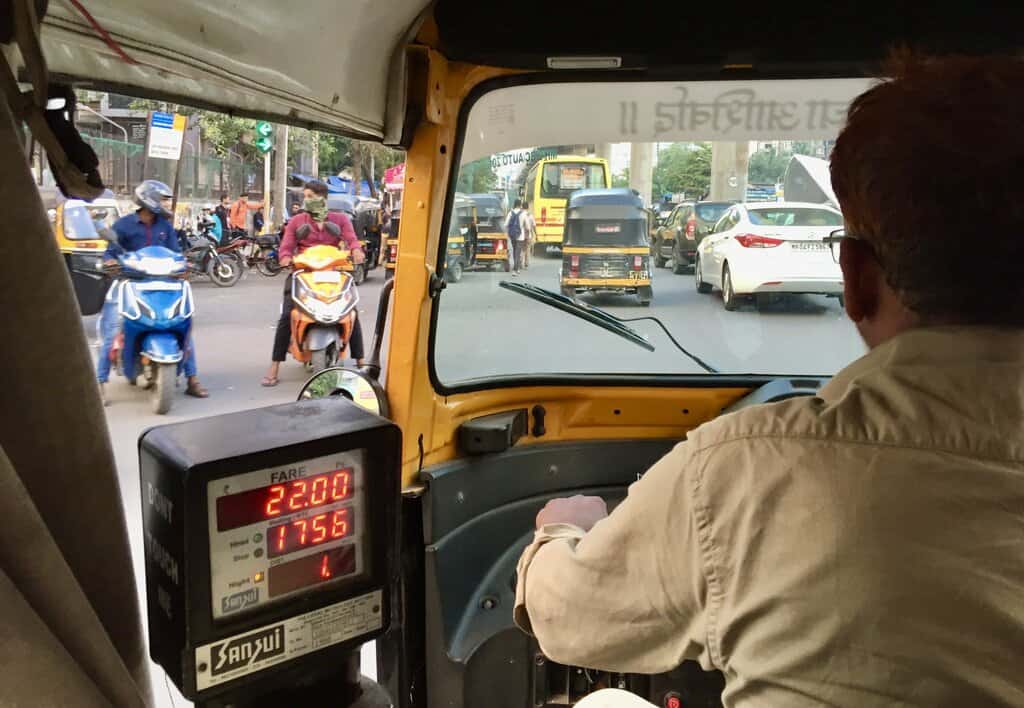
It’s highly advised not to attempt driving in India. Even if you are from Southeast Asia or Africa I still don’t recommend it. Indian roads are a whole different ball game.
All the rules of the road you know don’t apply to Indian roads. Organized chaos is the best way to describe it. The first time you see a busy Indian intersection will blow your mind. But somehow everything works out and everyone eventually gets through.
If you try to drive like in a western country you will never get anywhere. And I mean that literally. You will not be able to move your car forward following western rules of driving. You have to be aggressive in India. So for your own safety, it’s advised not to drive.
Instead, take tuktuks, taxis, Uber, or Ola. They are remarkably cheap and plentiful. Just be prepared to sit in the cab for a while, as getting from Point A to Point B in an Indian city can take an eternity.
#2) Prepare to see extreme poverty
Let’s start with the poverty you will see when you travel around India. While I could write the same thing to prepare a European for their first trip to the USA, poverty in India is on a different scale.
Hundreds of millions of people live in extreme poverty and income inequality is widespread. While the haves live like kings, the have-nots live in slums, many without running water and access to basic supplies.
The conditions of many people living on the street can be difficult to stomach the first time you see it. If you’ve never been to a developing nation before, it will be a shock.
If you are Caucasian, you will likely be approached by beggars on the street as they’ll assume you are rich. It’s okay to give them a few rupees. One image that always sticks with me is a young mother with two small children picking up 10 rupee bills (about $0.15 USD) as they fell to the ground during the blessings of my brother-in-law’s wedding.
During this ceremony people “make it rain” over the bride and groom with small bank notes. The woman scampering through the dancing wedding party to pick up the bills broke my heart.
I have never been inside one of the slum neighborhoods but they are everywhere in large cities and small villages alike. While slum tours of Mumbai are now a real thing, I don’t recommend this. In my opinion the poor living conditions of less fortunate people should not be for your entertainment.
But should you wish to visit, there are many tours that will take you and you show around the slums. The tours are usually a half-day and are less than $20 USD.
#3) Expect to see a lot of garbage due to lack of waste management
A result of the rampant poverty we just discussed, proper disposal of waste and recycling is nonexistent in the poorer neighborhoods. You will see garbage and plastic bottles littered on the side of the road. Even in the wealthier neighborhoods this can still happen.
You will also often see burning piles of garbage as you walk the streets of Indian cities. With nowhere to dump the garbage, the piles are often set on fire to burn away. The garbage on the side of the road can be very upsetting, especially to anyone who considers themselves an environmentalist.
In wealthier neighborhoods this is not really an issue. And garbage won’t be on fire outside your 5-star hotel. But it won’t take a long walk from that hotel to end up on a poor street without waste management.
#4) Be aware that animals are always on the road
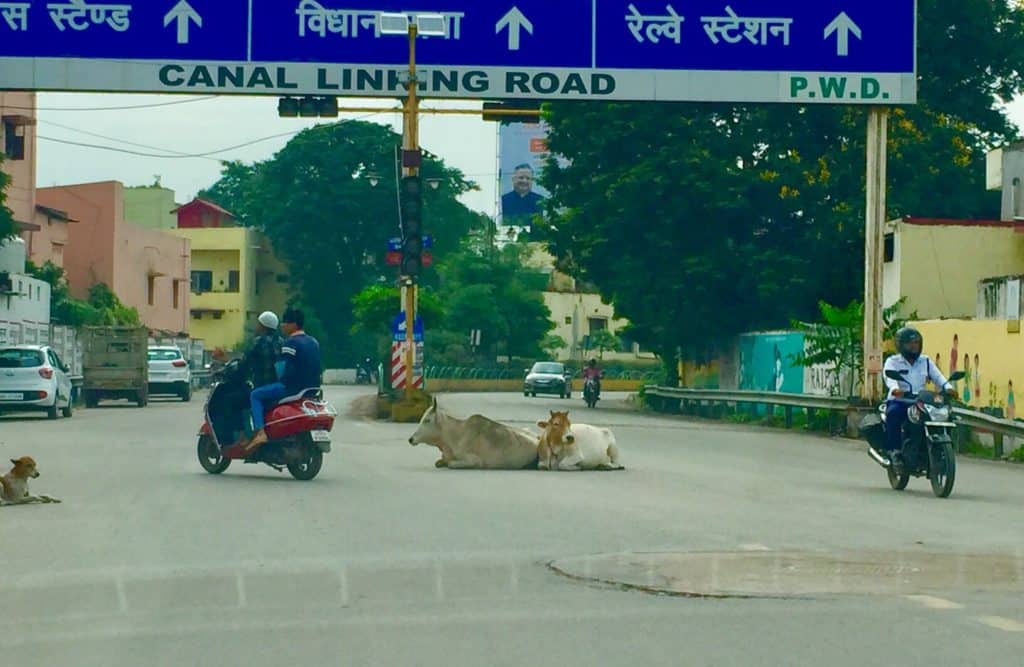
You probably know this by now, but cows are sacred in India. They also roam the cities freely, like stray dogs. However, unlike stray dogs, they like to chill on the road. Like, literally in the middle of the road.
It’s a pretty common sight in Indian cities to be heading down a road and have to move over to the shoulder to pass a sitting cow or a group of cows. The cows don’t care about you. You just have to avoid them. Luckily you won’t be driving (more on that later), but good to be prepared for anyways.
You will often see water buffalo in the road as well. Pigs and camels on the road are a less frequent site but can be seen sometimes. Drivers are used to it though, so it’s not really a cause for concern. And if you’re in Jaipur, you might encounter a few elephants walking down the road. No big deal.
#5) Be careful with street food (if you don’t want to get sick)
India has no doubt some of the best street food in the world. It’s literally everywhere and it’s usually delicious. But the thing is that street food is often made by people who don’t have access to clean water, so when you try it you’re taking a chance with catching something that will leave your stomach feeling like it’s tearing itself apart. The infamous Delhi Belly.
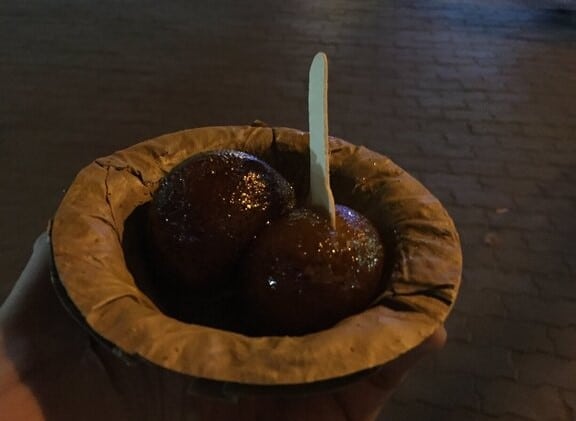
Now am I saying that if you eat some street food you’re definitely going to get sick? Absolutely not. Chances are you’ll be fine. But it’s a risk you will have to analyze for yourself and decide whether or not it’s worth it for you to try street food.
The street food in India is dirt cheap, and if you’re traveling on a budget it is by far the cheapest way to feed yourself. But if you’re not on a super strict budget I’d advise against street food, as I don’t feel it’s worth the risk. It’s up to you in the end, and if you do choose to eat street food be sure to use these tips for avoiding getting sick.
#6) Someone will want a photo with you
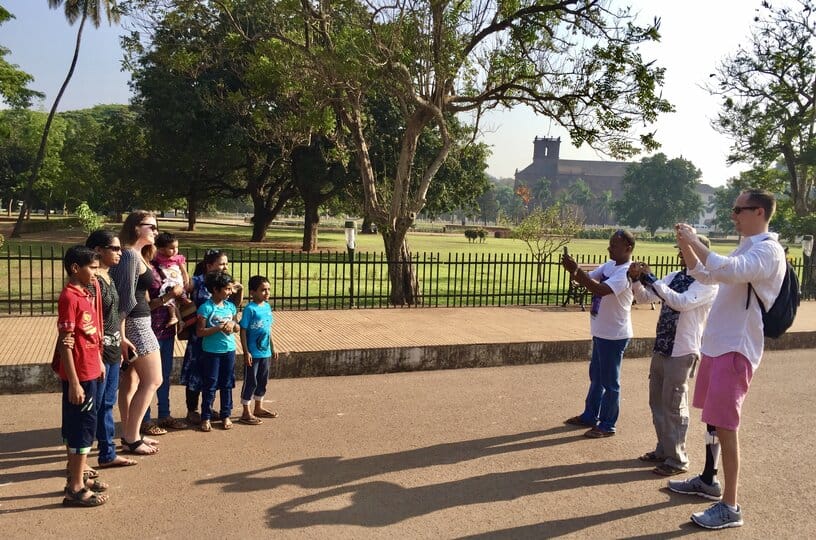
Being asked to pose for a photo with a random stranger might seem odd, but it happens all the time in India for Caucasians. If you are a tall white person, you will get even more requests. I can’t be sure if the same will happen for people of other races and ethnicities, but white people be prepared.
This won’t happen in places like Delhi, Mumbai, Jaipur or Agra where tourists are a regular sight, but if you’re anywhere else be prepared to be approached. While you might find it annoying, just be courteous and if you prefer not to pose for a photo with this random stranger politely tell them you’d rather not.
The only explanation for this my wife has is that some people just want to show their friends that they hang out with white people. If you find yourself in a small town or village outside of a city, it’s very likely that you will be the first white person that some of the children have ever seen.
#7) They don’t really use toilet paper
If you’re staying at a personal residence in India you might notice there is no toilet paper in the bathroom. You might think they’re out, but actually that’s how it’s supposed to be. There is a bucket and a hose instead. I’ll let you use your imagination there.
Don’t worry though, every hotel and most bathrooms in restaurants or office buildings or other public places will have toilet paper available along with the hose. If you’re going for a wedding (as many westerners do for their first India trip) and staying at someone’s house, just be sure to request they have toilet paper on hand if you’re not comfortable using the hose and bucket technique.
#8) Prepare for bone in your curry
If you’re a fan of Indian food at Indian restaurants in western countries, you might get a shock when your butter chicken comes with bones all in the chicken. This is how curries with meat are made in India. The chicken or goat (mutton) is chopped up without removing bones and cooked in the curry.
They say keeping the meat on the bones makes it more flavorful. If you’re not used to it though, it can be quite a challenge to eat an Indian curry avoiding the bones. You’ll have to get a bit messy, as it’s nearly impossible to eat with a fork or spoon. The locals make eating with your hands look like a piece of cake. It gets me every time though.
Most decent restaurants will offer a boneless chicken option that will cost extra. However, If you’re going to a wedding or some other event, you’re just gonna have to deal with the bones in your curry or stick to vegetarian options.
Speaking of vegetarian options, India is heaven for vegetarians. Many Indians are vegetarians, and most curry options are vegetarian. If you’ve never thought about ordering vegetarian food, India is the perfect place to try.
#9) Prices are negotiable
As with many Asian and African countries, price tags are not to be taken literally. Excluding things like hotels, menu prices at restaurants, and public transport fare, just about everything is negotiable in India. Haggling is common and literally everyone does it.
Some of the more common things to haggle on are items at any shop, taxi fare, tour prices, and any service provided by a company or individual. You might choose not to haggle though, especially if you’re well-off financially, knowing just how little the sellers and providers make.
#10) Travel documentation is needed to enter an airport
One unique thing about India is when you’re going to the airport for your flight, you need to show your flight confirmation to an Army guy with an M-16 just to get into the airport. So be sure to have either a printed flight confirmation or be able to show it on your phone. A screenshot is acceptable as you probably won’t have mobile data or wifi.
Without your flight confirmation you can’t enter the airport (so no seeing off your family and friends, you’ll have to waive goodbye to them from outside). I’ve seen something similar in Nairobi, but every airport in India requires flight confirmation for entrance.
#11) Be prepared to go through security everywhere
As a result of the 2008 Mumbai terrorist attack, security was ramped up throughout the country. Places where large crowds can gather will have metal detectors. It’s like if you’ve ever gone into a federal building in Washington DC where you have to go through the metal detectors, but for places you’d never expect to go through security in your home country.
Some examples of places you’ll have to go through metal detectors are: hotels, malls, subway stations, and movie theaters.
#12) 5-Star hotels can be pretty damn cheap
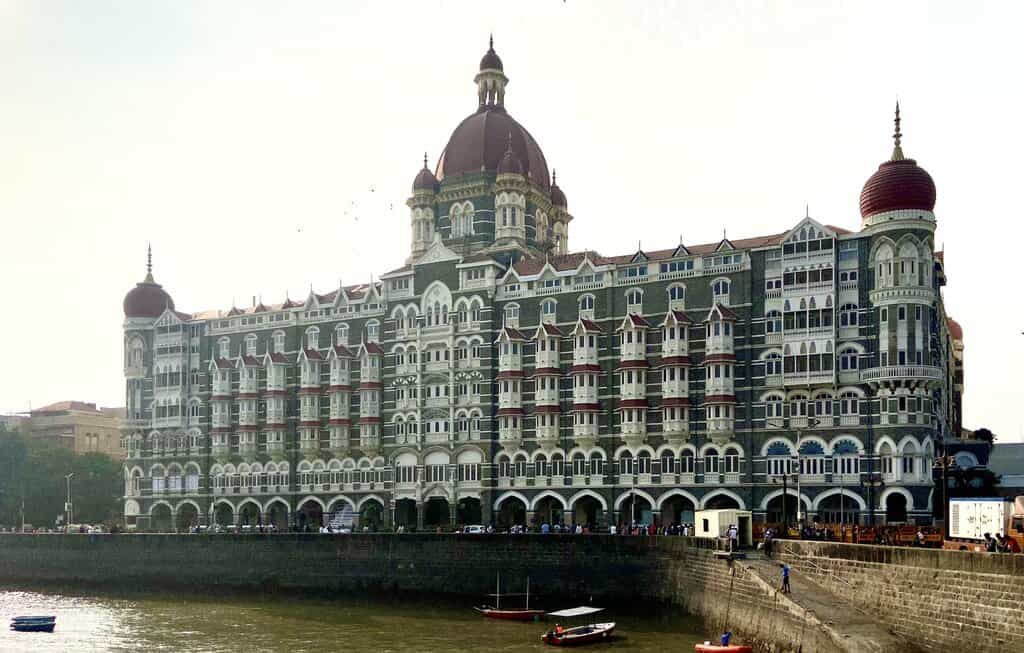
If you’ve never stayed in a fancy hotel before, India is the perfect place to pop your cherry. Really nice hotels in India can be surprisingly affordable, especially in the smaller cities.
If you’re in Delhi or Mumbai, you can reasonably expect to pay $200-$300 USD for a brand like JW Marriott, Four Seasons, or the Taj Mahal. Other not as top-of-the-line 5-star hotels will usually be under $200.
By the time you get to places like Lucknow and Amritsar and other smaller cities, you can start to find 5-star hotel prices in the $100-200 range. Even in tourist-heavy places like Agra and Jaipur you still have many 5-star options under $200 per night, like the Jaipur Marriott Hotel or the Grand Mercure Agra.
It’s also important to note here that hotel brands that you might not associate with “5-star” are actually 5-star in India. The best example of this is the Courtyard by Marriott. While in the US, Courtyard is usually a side-of-the-interstate hotel, in India it’s a super nice 5 star property. My brother-in-law got married at the Courtyard by Marriott in Bhopal. It was really fancy!
Some other examples of this would be Hyatt Place, Radisson, and Holiday Inn, all of which offer numerous 5-star options throughout India. Sure beats a run down Motel 6 in New Jersey that starts at $199/night!
#13) English is prevalent
One of the nice things for westerners about traveling around India is that English is prevalent among the Indian population. As a former British colony, English was mandated and it’s still taught in schools. If you want a Bollywood movie, you’ll often hear random sentences in English here and there.
Now, not everyone in India speaks English, of course. The less educated a person is, the less likely they are to speak English. But pretty much anyone with a university degree will speak English fluently. Plus anyone who works in hospitality and most signs are in Hindi and English.
You can get by visiting India without speaking a word of Hindi, so long as you speak English.
#14) Follow basic safety precautions
While India is overall a pretty safe country, it does have its share of violent crime. Murder and assault are not common, but it does happen. Solo female travelers should avoid walking alone at night on streets that are not busy and lighted.
If you follow basic safety precautions that you would follow in any major city around the world, you should be fine. There is far less violent crime than the United States.
My wife has in fact been robbed at a park in Raipur after dark and her Samsung phone was stolen. The lesson there was don’t walk around unlit places at night. As a westerner, you stand out more, so it’s even more important to follow the basic precautions.
#15) Don’t forget your tourist visa
India has visa-free travel for only three countries. So unless you’re from Nepal, Bhutan, or the Maldives, you need a tourist visa. Japanese and South Korean citizens can get a visa on arrival, but everyone else will have to apply ahead of time.
Most people will be able to apply for their tourist visa online, as India allows e-visas for 166 countries; just not China, Pakistan, Bangladesh, and countries it doesn’t have diplomatic relations with like Algeria, Chad, and some other African nations.
The process for applying for a tourist visa is constantly changing so consult the Indian e-Visa website for the latest information. You’ll need some unusual information like father’s place of birth, but most of it is pretty standard. Just be sure to follow their guidelines for the uploaded photo to the t, as you’ll be rejected if you don’t.
You can apply for a 30-day visa, a 1-year visa, or a 5-year visa. The price varies depending on the length, of course, and your nationality. Most visitors opt for the 30-day visa, which currently – as of the end of 2023 – runs $25 for a US citizen. It used to be over $100, so it’s been greatly reduced in recent years.

India Travel Tips – FAQs
Is tipping expected in India?
Moderate tipping is common in India, but not necessarily expected. Most food transactions are done with cash, and it’s customary to leave 10% if you received good service. This is often done in the form of leaving a 100 rupee bill on the table when you leave.
Do I need malaria tablets for India?
Malaria is prevalent in India in most cities and other areas under about 2000m (6560 ft) elevation. There is no mandate to take malaria tablets, but if you’re worried about catching the virus then it doesn’t hurt to get a prescription for them before your trip. I don’t personally take them for India unless I’m going outside the major cities, but for your first trip it might be a good idea.
What vaccinations do I need for India?
No vaccinations are required to enter India, but it’s good to be up to date on your TDAP, typhoid, yellow fever, Hepatitis A & B, and polio before your trip. Consult the CDC website for the latest information.
What are the safety tips for traveling in India?
While India has its share of issues with violent crime, it’s a safe country overall and assaults are not common. Follow basic precautions such as not walking alone at night unless the area is busy and well lit and you will likely be fine.
Is India friendly to tourists?
Indians are very friendly to tourists. They are very welcoming and hospitable. Service at Indian hotels and upscale restaurants is second to none. If you want to feel like royalty, a visit to India will do the trick!
Final Word
Now that we’ve gone through the top 15 India travel tips for first time visitors you should be prepared for your trip. India is a beautiful country and the people are truly warm and welcoming. As long as you are prepared for some of the main cultural differences you will face you will have a great time!


2 comments
[…] The Mosque. Photo courtesy of Around the World with Me. […]
[…] be approached by endless people begging you to buy something or give them money. If it’s your first time visiting India, this can be pretty overwhelming. Do your best to ignore and do not speak back to them. Sadly, this […]